
A roundhouse is the part of a post mill that encloses the trestle. It serves two functions; to protect the trestle from the weather and to provide storage space.

A roundhouse is the part of a post mill that encloses the trestle. It serves two functions; to protect the trestle from the weather and to provide storage space.
Early medieval post mills had their trestles partly buried in the ground. This gave the mill stability, but had the disadvantage that the trestle would rot where it met the ground. This type of mill was called the Sunk post mill. [1] By making the mill bigger, it was possible to raise the trestle out of the ground. [2] These mills are called open trestle post mills. [3] The trestle of the mill, whilst clear of the ground, is still exposed to the elements. By adding a structure around the trestle, it is protected from the elements, with the added advantage of creating additional dry storage space for grain and flour. These mills are called a post mill with roundhouse. [4] Some open trestle post mills had a roundhouse added later, for example Drinkstone, Suffolk c.1830. [5] Other mills were built with a roundhouse from new. [4] Single storey roundhouses had two doors directly opposite each other to give safe access and egress whichever way the wind was blowing from. [6]
A roundhouse is usually, but not always round. Polygonal roundhouses also exist. [4] A roundhouse may be of one, two or three storeys. The latter were most common amongst windmills in Suffolk, where the post mill reached its peak of design. A tall roundhouse raised the mill above the trees and enabled it to better catch the wind. Sometimes a mill was raised, such as the Black Mill, Southwold, Suffolk in 1863 following gale damage. It originally had a single-storey roundhouse, but had a two-storey roundhouse after it was rebuilt. [7] Generally, the roundhouse has no structural function, with the exception of roundhouses in the Midlands region of the United Kingdom, where they carried a curb and through wheels on the underside of the buck of the mill, they carried some weight from the mill, a task usually performed solely by the trestle. [6]
Often, when a post mill was demolished, the roundhouse was left standing. Some of these roundhouses survive, either as stores converted into dwellings.

Saxtead Green Post Windmill is a Grade II* listed post mill at Saxtead Green, Woodbridge, Suffolk, England which is also an Ancient Monument and has been restored.

The post mill is the earliest type of European windmill. Its defining feature is that the whole body of the mill that houses the machinery is mounted on a single vertical post, around which it can be turned to bring the sails into the wind.

Durrington or High Salvington Windmill is a Grade II listed post mill in High Salvington, Sussex that has been restored and is in full working order. The mill stands 320 feet (98 m) above sea level and is able to take advantage of incoming sea winds.

Oldland Windmill is an 18th-century post mill situated in the village of Keymer, West Sussex.
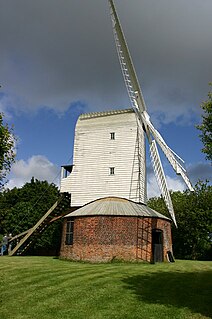
Thrigby Post Windmill is located in the civil parish of Mautby in the English county of Norfolk. The mill is on the south side of Mill Lane 1,125 yards (1.029 km) east of the village of Thrigby. The post mill is north of The River Bure, Breydon Water and the Halvergate Marshes.

New Mill is a Grade II listed post mill at Cross in Hand near Heathfield, East Sussex, England. It was the last windmill working commercially by wind in Sussex, ceasing work by wind in 1969 when a stock broke.

Windmill Hill Mill is a grade II* listed post mill at Herstmonceux, Sussex, England which has been restored and now operates as a working mill. The mill is open to the public on most Sundays from Easter until October.
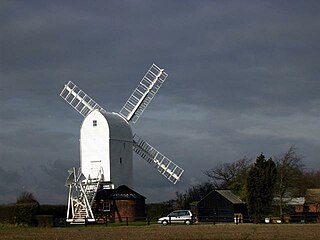
Aythorpe Roding Windmill is a Grade II* listed Post mill at Aythorpe Roding, Essex, England which has been restored to working order.

Mountnessing Windmill is a grade II* listed post mill at Mountnessing, Essex, England which has been restored to working order.

Ramsey Windmill is a grade II* listed post mill at Ramsey, Essex, England which has been restored.

Drinkstone Windmills are a pair of windmills at Drinkstone, Suffolk, England. They consist a post mill and a smock mill. The post mill is Grade I listed and the smock mill is Grade II* listed. The mills were known as Clover’s Mills as they were always worked by the Clover family.

Framsden Windmill is a Grade II* listed post mill at Framsden, Suffolk, England which is preserved. The mill was known as Webster's Mill when it was a working mill.
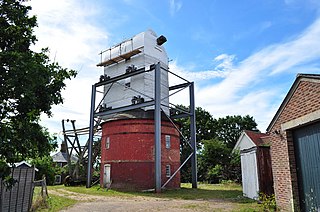
Friston Windmill is a Grade II* listed post mill at Friston, Suffolk, England which has been conserved.
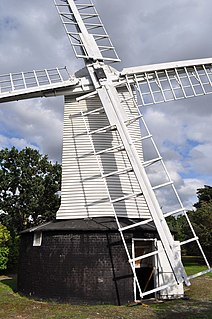
Holton Windmill is a Grade II listed post mill at Holton, Suffolk, England which has been preserved as a landmark.

Upthorpe Mill is a Grade II* listed post mill and Scheduled Ancient Monument at Stanton, Suffolk, England, which has been restored to working order.
Syleham Windmill was a Grade II listed post mill at Syleham, Suffolk, England which was built in 1730 at Wingfield and moved to Syleham in 1823. It was blown down on 16 October 1987. The remains of the mill survive today, comprising the roundhouse and trestle.

Crowfield Windmill is a smock mill at Crowfield, Suffolk, England which has been conserved.
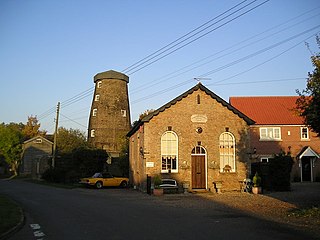
Buxhall Mill is a tower mill at Buxhall, Suffolk, England which has been converted to residential accommodation.

Skoulding's Mill is a Grade II listed tower mill at Kelsale, Suffolk, England which has been converted to residential accommodation.

Lound Mill is a tower mill at Lound, Suffolk, England which has been converted to residential accommodation.